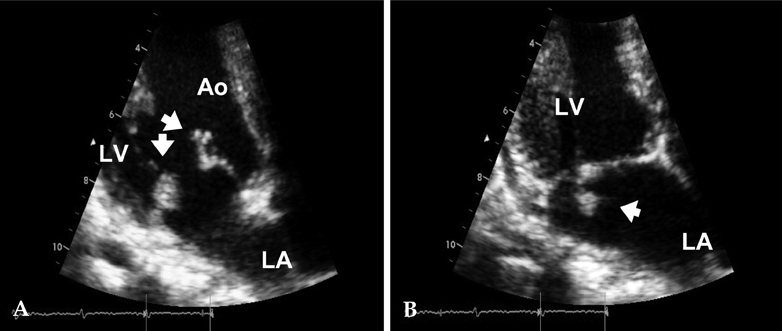Yonsei Med J.
2009 Feb;50(1):152-155. 10.3349/ymj.2009.50.1.152.
A Case of Primary Infective Endocarditis Caused by Community-Associated Methicillin-Resistant Staphylococcus aureus in a Healthy Individual and Colonization in the Family
- Affiliations
-
- 1Department of Internal Medicine, Gachon University Gil Hospital, Incheon, Korea. yspark@gilhospital.com
- 2Department of Laboratory Medicine, Gachon University Gil Hospital, Incheon, Korea.
- 3Catholic Research Institutes of Medical Science, The Catholic University of Korea, Seoul, Korea.
- KMID: 1782982
- DOI: http://doi.org/10.3349/ymj.2009.50.1.152
Abstract
- Primary community-associated methicillin-resistant Staphylococcus aureus (CA-MRSA) endocarditis has rarely been reported in healthy individuals without risk factors, such as skin and soft tissue infections, and intravenous drug abuse. We describe a case of infective endocarditis by CA-MRSA (ST72-PVL negative-SCCmec IVA) in previously healthy individuals with no underlying medical condition and CA-MRSA colonization in the family.
Keyword
MeSH Terms
Figure
Reference
-
1. Crum NF. The emergence of severe, community-acquired methicillin-resistant Staphylococcus aureus infections. Scand J Infect Dis. 2005. 37:651–656.
Article2. Zetola N, Francis JS, Nuermberger EL, Bishai WR. Community-acquired meticillin-resistant Staphylococcus aureus: an emerging threat. Lancet Infect Dis. 2005. 5:275–286.
Article3. Bahrain M, Vasiliades M, Wolff M, Younus F. Five cases of bacterial endocarditis after furunculosis and the ongoing saga of community-acquired methicillin-resistant Staphylococcus aureus infections. Scand J Infect Dis. 2006. 38:702–707.
Article4. Tsigrelis C, Armstrong MD, Vlahakis NE, Batsis JA, Baddour LM. Infective endocarditis due to community-associated methicillin-resistant Staphylococcus aureus in injection drug users may be associated with Panton-Valentine leukocidin-negative strains. Scand J Infect Dis. 2007. 39:299–302.
Article5. Fowler VG Jr, Miro JM, Hoen B, Cabell CH, Abrutyn E, Rubinstein E, et al. Staphylococcus aureus endocarditis: a consequence of medical progress. JAMA. 2005. 293:3012–3021.6. Oliveira DC, de Lencastre H. Multiplex PCR strategy for rapid identification of structural types and variants of the mec element in methicillin-resistant Staphylococcus aureus. Antimicrob Agents Chemother. 2002. 46:2155–2161.
Article7. Millar BC, Prendergast BD, Moore JE. Community-associated MRSA (CA-MRSA): an emerging pathogen in infective endocarditis. J Antimicrob Chemother. 2008. 61:1–7.
Article8. Ako J, Ikari Y, Hatori M, Hara K, Ouchi Y. Changing spectrum of infective endocarditis: review of 194 episodes over 20 years. Circ J. 2003. 67:3–7.
Article9. Lin JC, Wu JS, Chang FY. Community-acquired methicillin-resistant Staphylococcus aureus endocarditis with septic embolism of popliteal artery: a case report. J Microbiol Immunol Infect. 2000. 33:57–59.10. Kim SY, Kim JY, Lee HS, Park C, Park YS, Seo YH, et al. A case of acute pyelonephritis caused by community acquired methicillin-resistant Staphylococcus aureus. Infect Chemother. 2007. 39:100–103.11. Kim ES, Song JS, Lee HJ, Choe PG, Park KH, Cho JH, et al. A survey of community-associated methicillin-resistant Staphylococcus aureus in Korea. J Antimicrob Chemother. 2007. 60:1108–1114.
Article12. Park C, Lee DG, Kim SW, Choi SM, Park SH, Chun HS, et al. Predominance of community-associated methicillin-resistant Staphylococcus aureus strains carrying staphylococcal chromosome cassette mec type IVA in South Korea. J Clin Microbiol. 2007. 45:4021–4026.
Article13. von Eiff C, Becker K, Machka K, Stammer H, Peters G. Nasal carriage as a source of Staphylococcus aureus bacteremia. Study Group. N Engl J Med. 2001. 344:11–16.
Article14. Wertheim HF, Vos MC, Ott A, van Belkum A, Voss A, Kluytmans JA, et al. Risk and outcome of nosocomial Staphylococcus aureus bacteraemia in nasal carriers versus non-carriers. Lancet. 2004. 364:703–705.
Article
- Full Text Links
- Actions
-
Cited
- CITED
-
- Close
- Share
- Similar articles
-
- A Fatal Case of Infective Endocarditis Caused by Community-Associated Methicillin-Resistant Staphylococcus aureus ST72 in Korea
- Community-acquired Methicillin-resistant Staphylococcus aureus Bacteremia Complicated by Acute Cholecystitis
- A case of tricuspid valve endocarditis with septic pneumonia caused by methicillin-resistant Staphylococcus aureus in a healthy woman
- A case of multiple furunculosis caused by methicillin-resistant staphylococcs aureus
- Community-associated methicillin-resistant Staphylococcus aureus (CA-MRSA)



